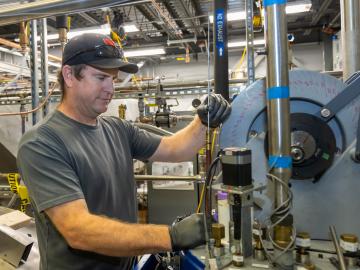Filter News
Area of Research
- Advanced Manufacturing (4)
- Biology and Environment (49)
- Building Technologies (1)
- Clean Energy (50)
- Climate and Environmental Systems (3)
- Computational Biology (1)
- Computational Engineering (2)
- Computer Science (10)
- Fusion and Fission (7)
- Fusion Energy (6)
- Isotopes (11)
- Materials (22)
- Materials for Computing (2)
- Mathematics (1)
- National Security (7)
- Neutron Science (29)
- Nuclear Science and Technology (5)
- Quantum information Science (3)
- Supercomputing (23)
- Transportation Systems (1)
News Type
News Topics
- (-) Artificial Intelligence (16)
- (-) Biomedical (19)
- (-) Climate Change (35)
- (-) Composites (11)
- (-) Computer Science (51)
- (-) Decarbonization (22)
- (-) Environment (79)
- (-) Fusion (16)
- (-) Isotopes (13)
- (-) Neutron Science (35)
- (-) Physics (21)
- (-) Security (7)
- 3-D Printing/Advanced Manufacturing (42)
- Advanced Reactors (15)
- Big Data (20)
- Bioenergy (31)
- Biology (37)
- Biotechnology (6)
- Buildings (27)
- Chemical Sciences (15)
- Clean Water (19)
- Coronavirus (17)
- Critical Materials (13)
- Cybersecurity (9)
- Energy Storage (45)
- Exascale Computing (3)
- Frontier (3)
- Grid (27)
- High-Performance Computing (19)
- Hydropower (8)
- Irradiation (2)
- ITER (4)
- Machine Learning (14)
- Materials (42)
- Materials Science (45)
- Mathematics (4)
- Mercury (7)
- Microscopy (20)
- Molten Salt (5)
- Nanotechnology (18)
- National Security (18)
- Net Zero (3)
- Nuclear Energy (32)
- Partnerships (1)
- Polymers (13)
- Quantum Computing (5)
- Quantum Science (12)
- Simulation (10)
- Space Exploration (10)
- Statistics (1)
- Summit (8)
- Sustainable Energy (57)
- Transportation (47)
Media Contacts

Associate Technician Sean Hollander is the keeper of the Fundamental Neutron Physics Beamline, which is operated by the Physics Division at the Spallation Neutron Source at ORNL, where scientists use neutrons to study all manner of matter.

ORNL scientists develop a sample holder that tumbles powdered photochemical materials within a neutron beamline — exposing more of the material to light for increased photo-activation and better photochemistry data capture.

A technology developed by Oak Ridge National Laboratory works to keep food refrigerated with phase change materials, or PCMs, while reducing carbon emissions by 30%.

Mohamad Zineddin hopes to establish an interdisciplinary center of excellence for nuclear security at ORNL, combining critical infrastructure assessment and protection, risk mitigation, leadership in nuclear security, education and training, nuclear security culture and resilience strategies and techniques.

Howard Wilson explores how to accelerate the delivery of fusion energy as Fusion Pilot Plant R&D lead at ORNL. Wilson envisions a fusion hub with ORNL at the center, bringing together the lab's unique expertise and capabilities with domestic and international partnerships to realize the potential of fusion energy.

Groundwater withdrawals are expected to peak in about one-third of the world’s basins by 2050, potentially triggering significant trade and agriculture shifts, a new analysis finds.

Cheekatamarla is a researcher in the Multifunctional Equipment Integration group with previous experience in product deployment. He is researching alternative energy sources such as hydrogen for cookstoves and his research supports the decarbonization of building technologies.

An international team using neutrons set the first benchmark (one nanosecond) for a polymer-electrolyte and lithium-salt mixture. Findings could produce safer, more powerful lithium batteries.

Alyssa Carrell started her science career studying the tallest inhabitants in the forest, but today is focused on some of its smallest — the microbial organisms that play an outsized role in plant health.

ORNL’s Assaf Anyamba has spent his career using satellite images to determine where extreme weather may lead to vector-borne disease outbreaks. His work has helped the U.S. government better prepare for outbreaks that happen during periods of extended weather events such as El Niño and La Niña, climate patterns in the Pacific Ocean that can affect weather worldwide.




